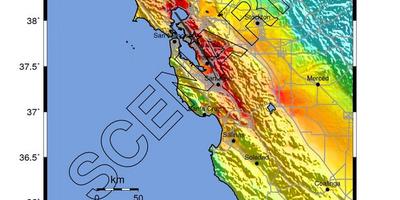Due to a lapse in appropriations, the majority of USGS websites may not be up to date and may not reflect current conditions. Websites displaying real-time data, such as Earthquake and Water and information needed for public health and safety will be updated with limited support. Additionally, USGS will not be able to respond to inquiries until appropriations are enacted. For more information, please see www.doi.gov/shutdown
Science Application for Risk Reduction
The SAFRR Project
Innovating the application of hazard science.
Home
Our SAFRR team focuses on building partnerships to improve the use of natural hazards information. We identify information needs and gaps and develop new products that make our science more available to users such as emergency managers, community members, or decision-makers. These efforts increase public safety and reduce economic losses caused by natural hazards.
SAFRR's HayWired Scenario

The HayWired scenario resources prepare the San Francisco Bay area.
USGS HayWiredNews
USGS Rolls Out Groundbreaking Earthquake Study: The HayWired Earthquake Scenario
USGS collaborates with key academic, state, local, and industry partners to provide a new look at what could happen during a major earthquake in the San Francisco Bay Area.
Earthquake Early Warning: Vital for City Transit
Although no one can reliably predict earthquakes, today’s technology is advanced enough to rapidly detect seismic waves as an earthquake begins, calculate the maximum expected shaking, and send alerts to surrounding areas before damage can occur. This technology is known as “earthquake early warning” (EEW).
History of Abrupt Sinking of the Seal Beach Wetlands: New Study Reveals Past Quakes along Fault and Offers Glimpse into the Future
Seal Beach, Calif.— A new collaborative study shows evidence of prior abrupt sinking of the wetlands near Seal Beach, caused by ancient earthquakes that shook the area at least three times in the past 2,000 years, according to researchers.
Publications
The HayWired Earthquake Scenario
ForewordThe 1906 Great San Francisco earthquake (magnitude 7.8) and the 1989 Loma Prieta earthquake (magnitude 6.9) each motivated residents of the San Francisco Bay region to build countermeasures to earthquakes into the fabric of the region. Since Loma Prieta, bay-region communities, governments, and utilities have invested tens of billions of...
Detweiler, Shane T.; Wein, Anne M.The HayWired Earthquake Scenario—Earthquake Hazards
The HayWired scenario is a hypothetical earthquake sequence that is being used to better understand hazards for the San Francisco Bay region during and after an earthquake of magnitude 7 on the Hayward Fault. The 2014 Working Group on California Earthquake Probabilities calculated that there is a 33-percent likelihood of a large (magnitude 6.7 or...
Detweiler, Shane T.; Wein, Anne M.Get your science used—Six guidelines to improve your products
Introduction Natural scientists, like many other experts, face challenges when communicating to people outside their fields of expertise. This is especially true when they try to communicate to those whose background, knowledge, and experience are far distant from that field of expertise. At a recent workshop, experts in risk communication offered...
Perry, Suzanne C.; Blanpied, Michael L.; Burkett, Erin R.; Campbell, Nnenia M.; Carlson, Anders; Cox, Dale A.; Driedger, Carolyn L.; Eisenman, David P.; Fox-Glassman, Katherine T.; Hoffman, Sherry; Hoffman, Susanna M.; Jaiswal, Kishor S.; Jones, Lucile M.; Luco, Nicolas; Marx, Sabine M.; McGowan, Sean M.; Mileti, Dennis S.; Moschetti, Morgan P.; Ozman, David; Pastor, Elizabeth; Petersen, Mark D.; Porter, Keith A.; Ramsey, David W.; Ritchie, Liesel A.; Fitzpatrick, Jessica K.; Rukstales, Kenneth S.; Sellnow, Timothy L.; Vaughon, Wendy L.; Wald, David J.; Wald, Lisa A.; Wein, Anne; Zarcadoolas, Christina







